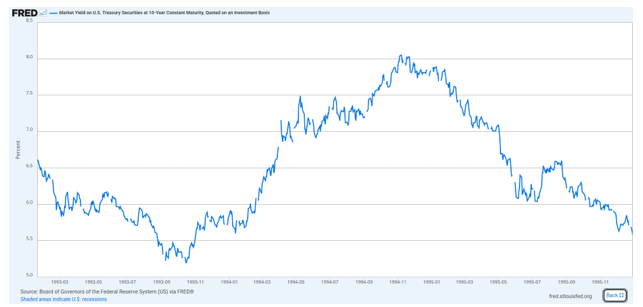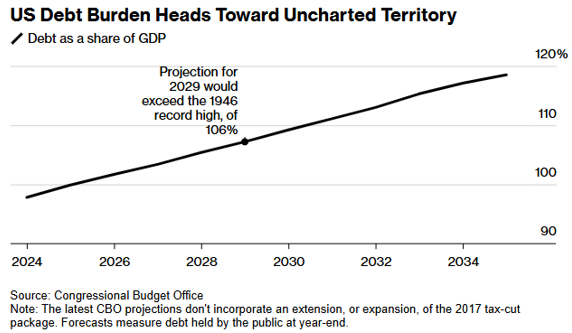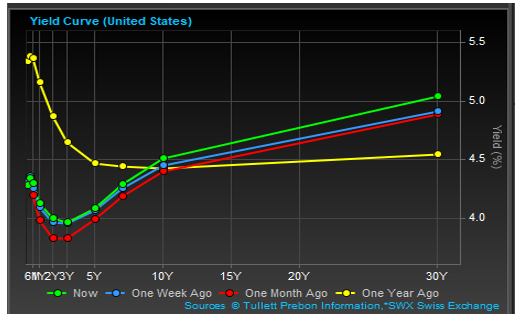Written by: Chris Fasciano, Chief Market Strategist | Commonwealth Financial Network
"I used to think that if there was reincarnation, I wanted to come back as the president or the pope or as a .400 baseball hitter. But now I would like to come back as the bond market. You can intimidate everybody." — James Carville
James Carville was President Bill Clinton’s chief strategist during his presidential campaign and served as a consultant and sounding board for Clinton during his presidency. His quote above referred to some of the difficulties the Clinton administration had early in the first term. From October 1993 to November 1994, yields on the 10-year U.S. Treasury bond rose from 5.2 percent to 8 percent, as seen in the chart below. (1)

Source: Board of Governors of the U.S. Federal Reserve System via FRED
In large part, the bond market’s reaction was due to concerns about the spending proposals coming from the new administration and what they could mean for the deficit. As a result of yield movement, guidance from a Treasury Secretary with ties to Wall Street, and the help of Republicans who controlled the House and Senate, spending plans were tempered. President Clinton focused on reducing the deficit, and bond yields declined. By the end of his second term (1998–2001), the U.S. ran a budget surplus. It was the last time the country did so.
Spotlight on the Debt and Deficit
The U.S debt level has been and continues to be a concern. Moody’s Ratings downgrade of the U.S. government credit rating on May 16 put a spotlight on the deficit and the debt level. S&P Global Ratings was the first agency to downgrade the U.S. in August 2011, with Fitch following 12 years later. The concern that these agencies have is easy to see in the following chart: (2)

Source: Bloomberg
The Congressional Budget Office calculations assume the sunset of the 2017 Tax Cuts and Jobs Act, which seems unlikely given the current bill approved in the House. It is estimated that the bill will add more than $2 trillion to the deficit in the next 10 years.
This is not a new issue for investors. So far, they have tended to look through any implications for the economy and what that might mean for the equity markets. Investors have long believed that the U.S. can address its fiscal situation when necessary. If that confidence remains in place, it is unlikely the U.S. is headed for a “Truss” moment like the U.K. experienced in 2022 around its government fiscal policies.
Still, today’s backdrop is different from what we have seen in the past. Economic growth estimates are currently declining at a time when interest rates (see chart below) and the cost to service the country’s debt are rising. (3)

Source: FactSet
Long-term Treasury rates have moved higher over the past year, and they are considerably higher than they have been during most of the prior decade. At current interest rates, it is estimated that debt service will cost more than the U.S. spends on Medicare, Medicaid, and defense spending.
Where Do We Go from Here?
Concerns about the deficit, its impact on interest rates, and what that could mean for economic growth are higher than they have been in some time. Still, some scenarios could help alleviate those worst-case fears.
While deficit concerns are currently playing out through the lens of the current budget bill in Congress, the growing deficit has spanned multiple administrations, both Democratic and Republican. The fate of today’s budget bill is still unknown. Some Republican senators have expressed concerns about the size of the bill. While changes in the Senate are likely, at the end of the day, a bill similar to what the House passed is probably a good guide for what will be signed into law. But as seen during the Clinton administration, one bill in isolation isn’t a solution, but a change in commitment on the deficit could be. Revenues from the existing tariffs and potential asset sales could come after the passage of a bill to help fill the gap.
The budget negotiations are continuing to play out against a backdrop of tariffs and trade deal negotiations. These items have weighed on soft economic data as well as expected earnings growth for the rest of the year. Our view all along has been that tariffs are being used as a negotiating tactic to get better trade deals. While it has admittedly been a rollercoaster ride, that still seems to be the likely outcome. Therefore, the best-case scenario for investors is to see continued progress on trade deals that reduce or eliminate the existing tariffs. This should allow for faster economic growth in the back half of the year. If better growth comes with lower inflation, then the Fed could also return to lowering interest rates. This would begin to repair investor confidence.
Weather the Storm with Diversification
Markets have recovered from their post-Liberation Day sell-off. Investors are feeling better about the outlook. But there are still clouds on the horizon. There will be another downdraft in the market. There always is. It might be this year. It might be next year. But it will happen.
Remembering the concern that investors had just two months ago can be a useful guide. Investors should ensure that their long-term goals are still appropriate. A well-thought-out plan should factor in when an investor may need cash, whether it is to buy a house, fund a college education, or generate income in retirement. Portfolios should be structured to achieve those goals over the next 3 to 6 months, as well as the next 5 to 10 years.
As long as the market focuses on the headlines of the day, volatility will continue. Diversification can help weather any storm going forward.
Related: Who Really Owns a Home? The Landlord-Tenant Paradox


